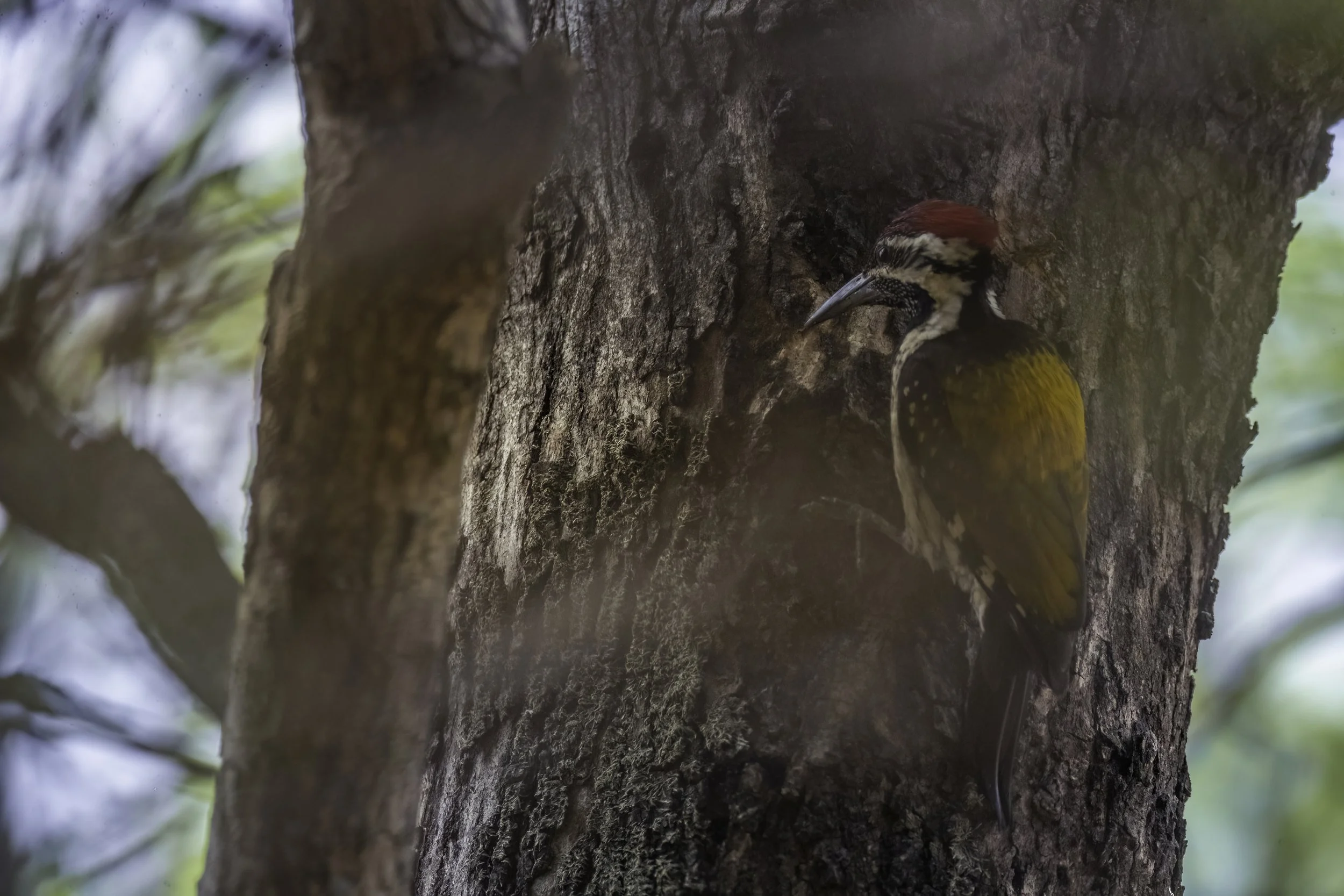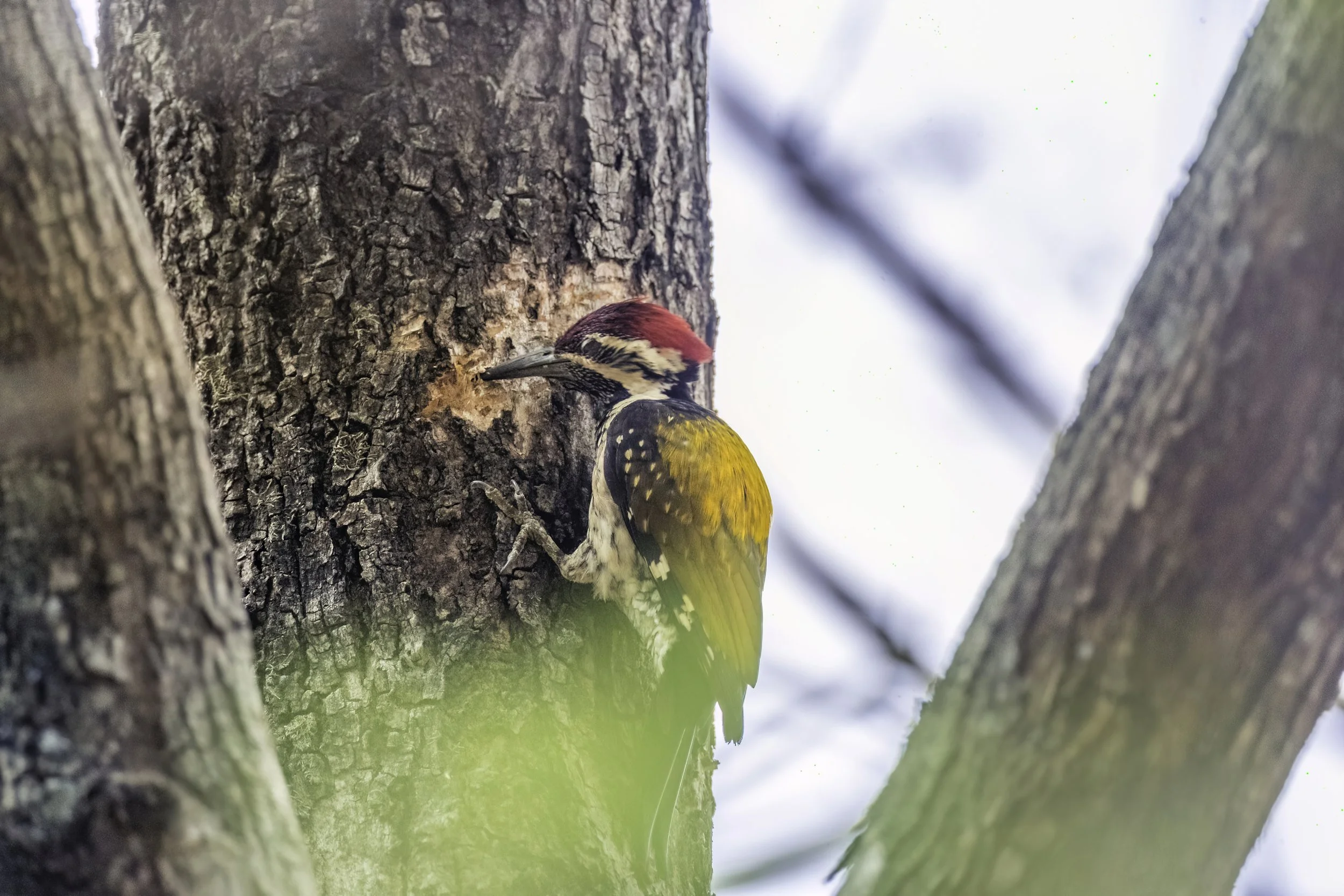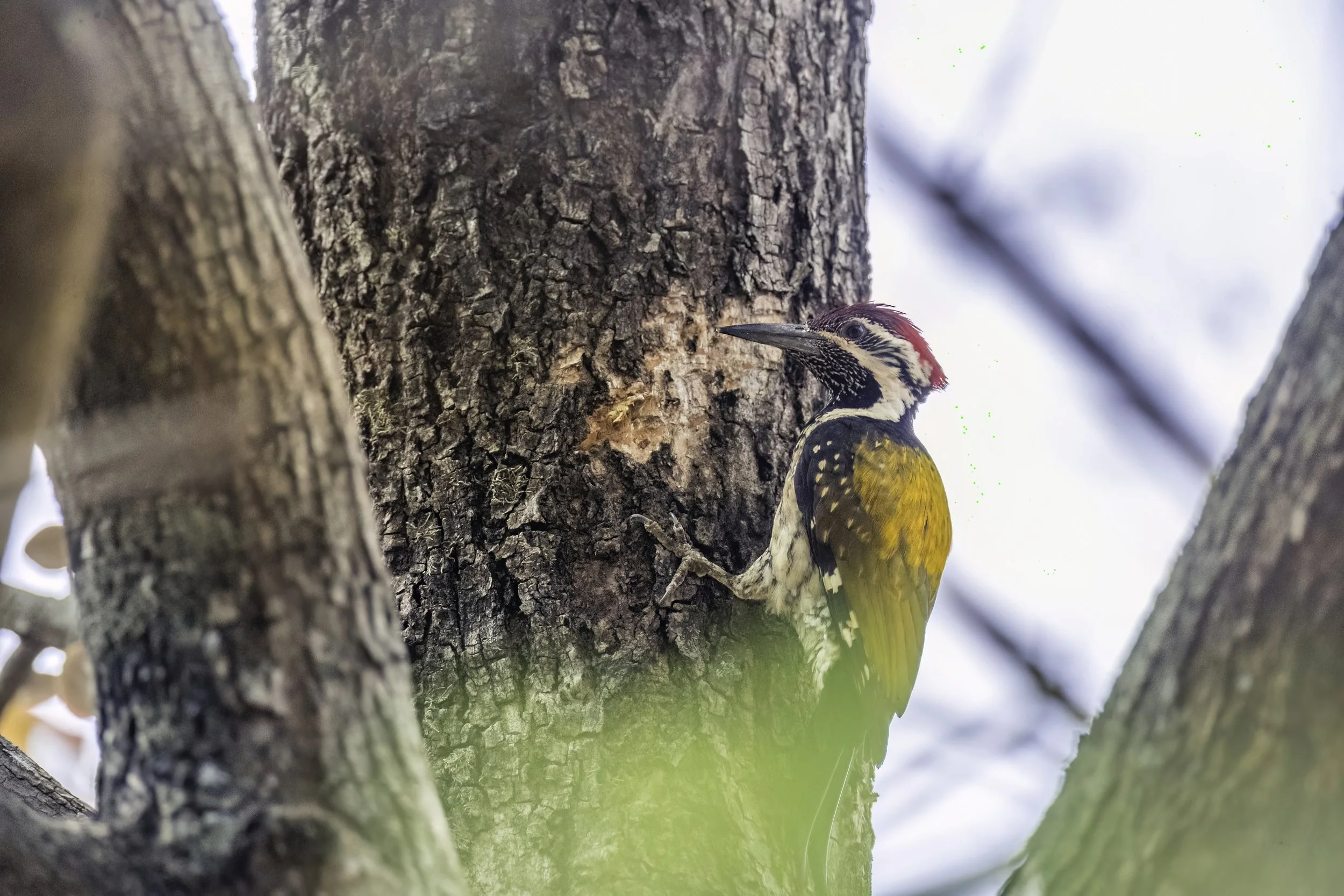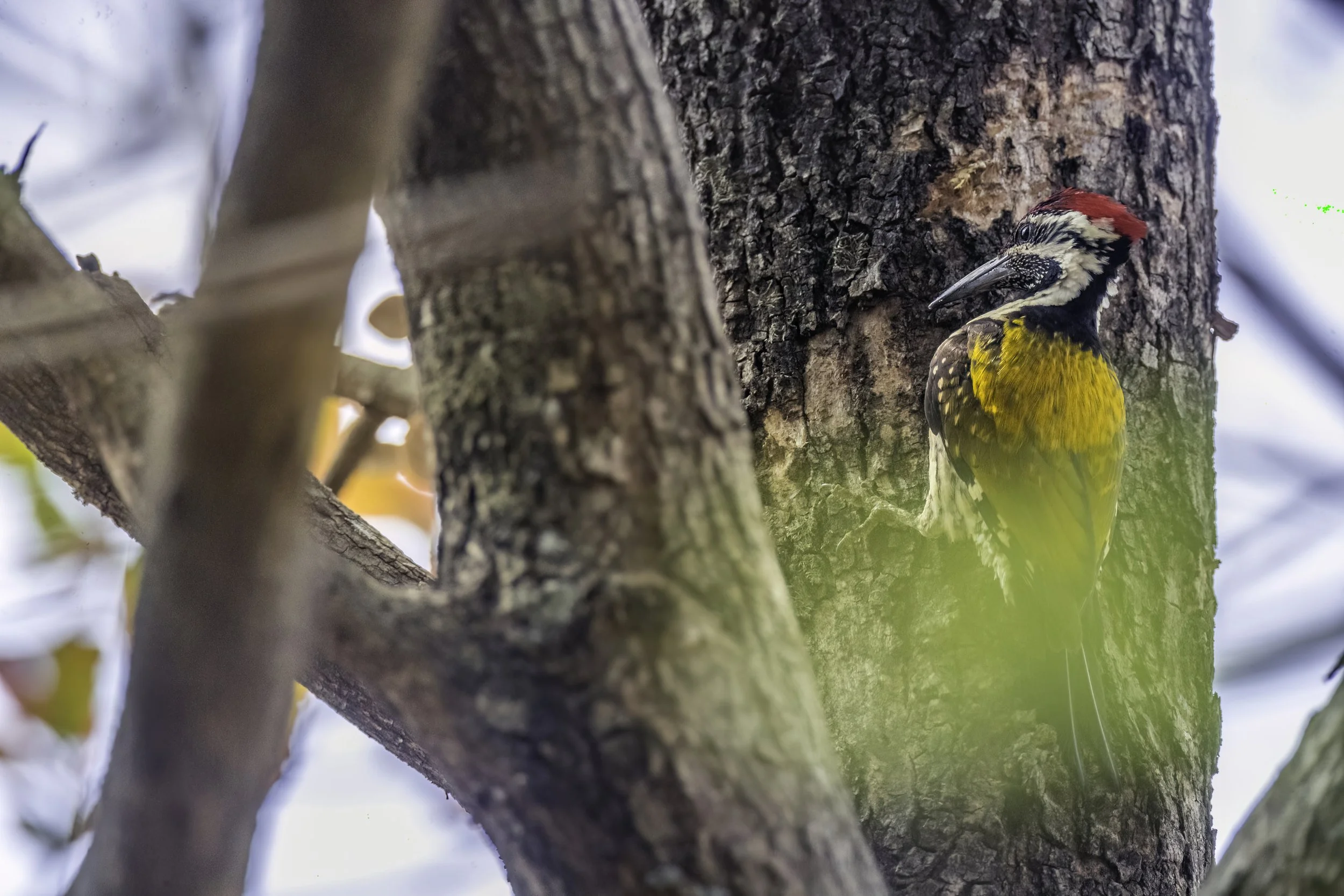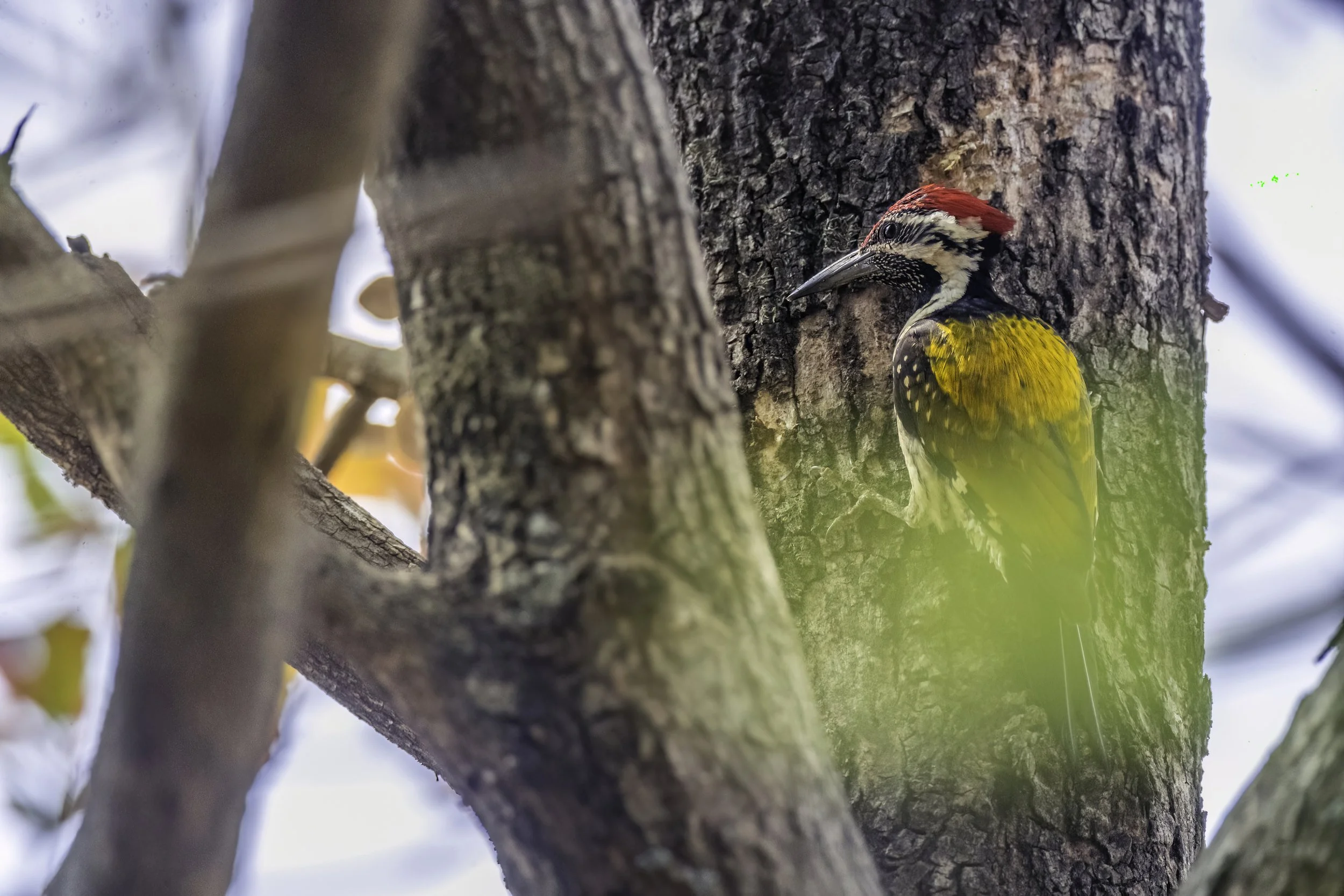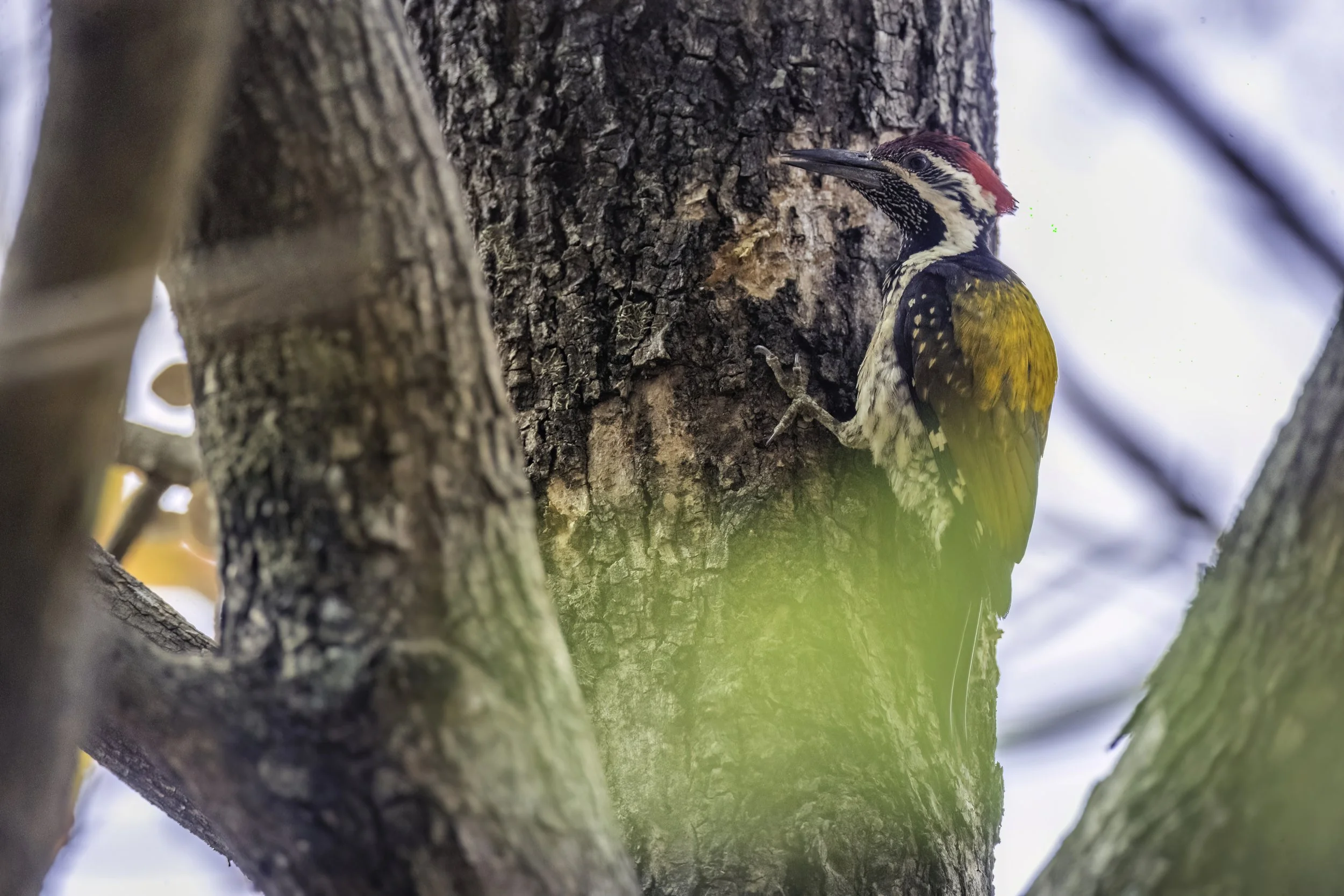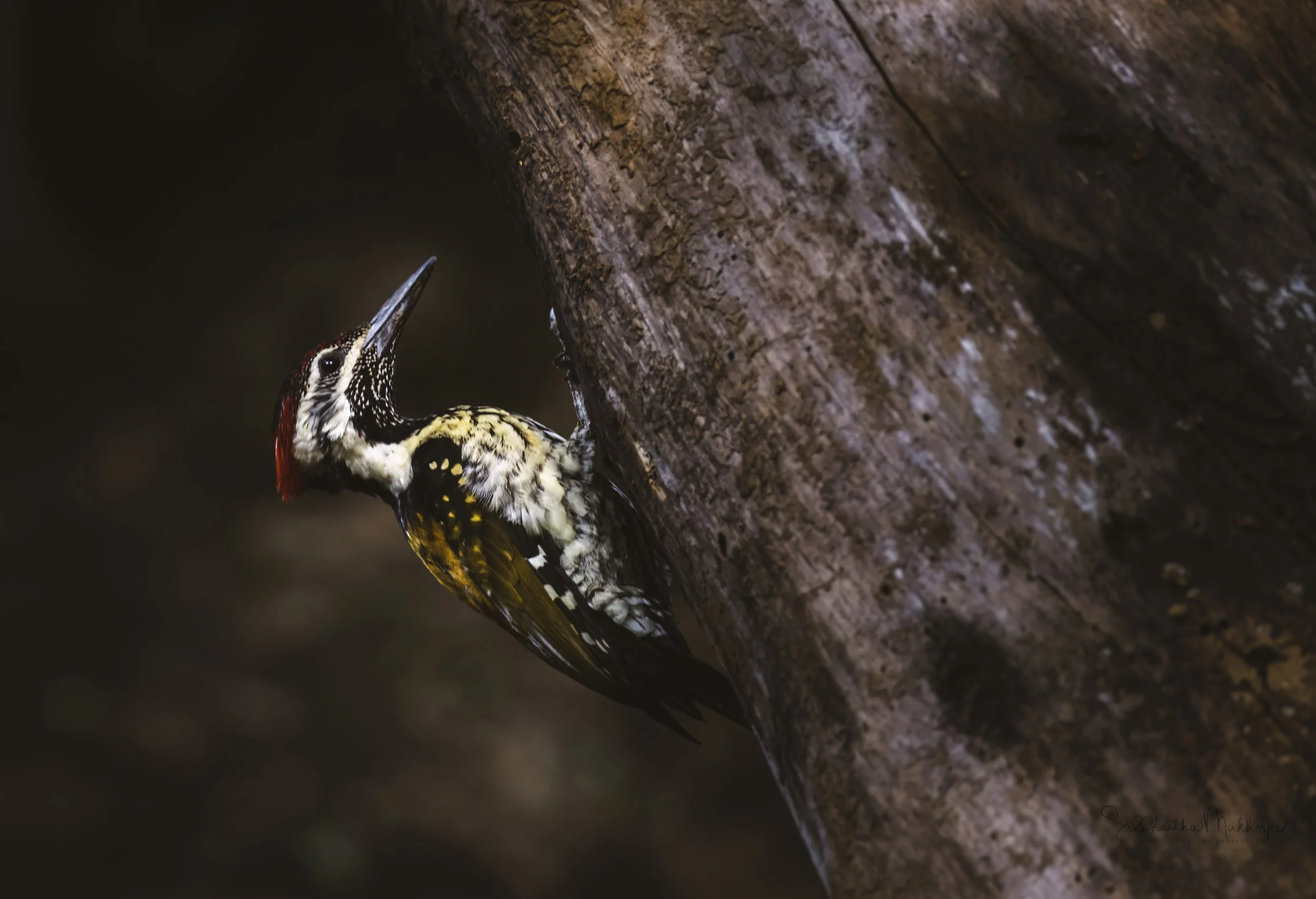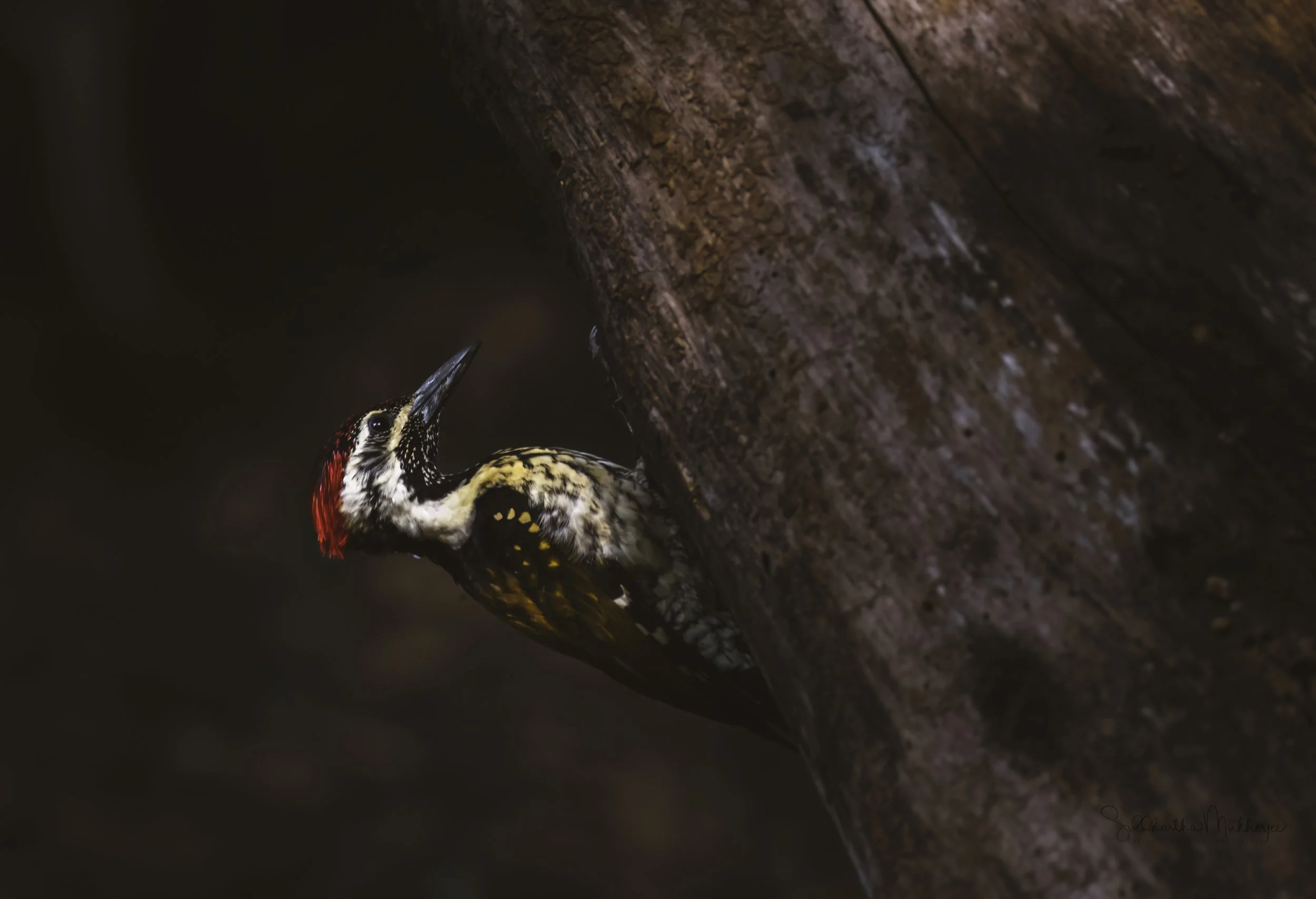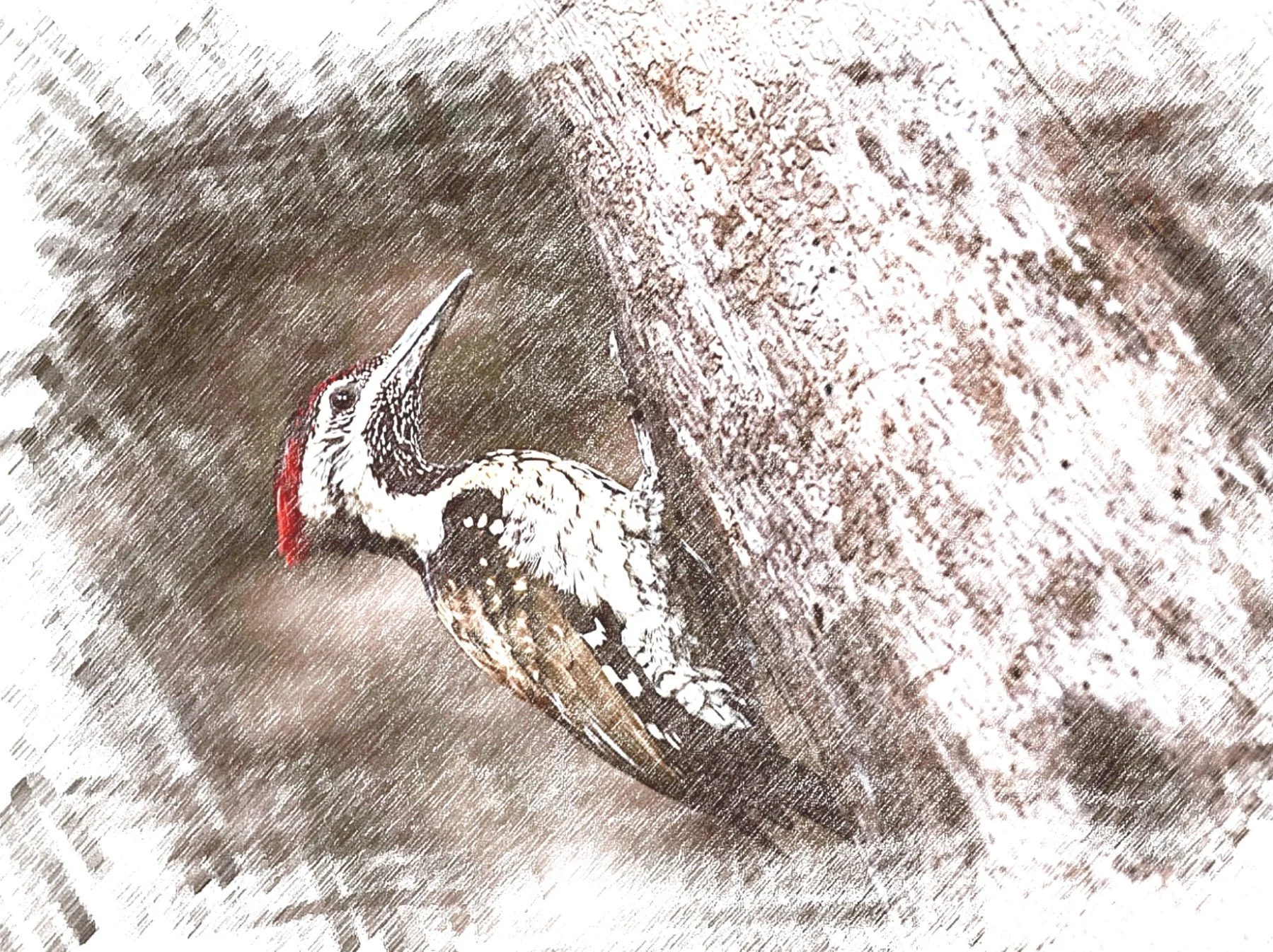Black-rumped Flameback/ Lesser Golden-backed Woodpecker
Dinopium benghalense
Ananthagiri Forest Range, Vikarabad
Located in the central stretch of the Deccan Plateau, Telangana has sub-tropical climate and the terrain consists mostly of hills, mountain ranges, and thick dense forests covering an area of 27,292 km² (10,538 sq mi). The annual rainfall ranges between 1,100 mm to 1,200 mm and the annual temperature varies from 15 C to 45 C. The State is drained by a number of rivers which include Godavari and Krishna.
Telangana is endowed with rich diversity of flora and fauna. It has dense teak forests on the northern part along the banks of river Godavari. As per the Champion & Seth Classification of Forest Types (1968), the forests in Telangana belong to three Forest Type groups, which are further divided into 12 Forest Types. The State Government has taken up a massive greening programme, 'Telangana Ku Harita Haram' in the State to plant and protect 230 crore seedlings over a period of 4 years. This initiative aims at achieving the twin objectives of increasing the forest cover and reduce pressure on the existing forest resources, through massive community participation by Vana Samrakshna Samithis (VSS) and Eco-Development Committees (EDCs) in Protected Areas and Watershed Development Committees in the Watershed areas. Recorded Forest Area (RFA) in the State is 26,904 km² of which 20,353 km² is Reserved Forest, 5,939 km² is Protected Forest and 612 km² is Unclassed Forests. In Telangana, during the period 1st January 2015 to 5th February 2019, a total of 9,420 hectares of forest land was diverted for non-forestry purposes under the Forest Conservation Act, 1980 (MoEF & CC, 2019). As per the information received from the State during that last two years, 12,730 ha of plantations including avenue plantations in the State.
Three National Parks and nine Wildlife Sanctuaries constitute the Protected Area network of the State covering 5.08% of its geographical area and our focus area today is the northern fringe of the Nallamalla forest located both in Telangana and Andhra Pradesh. It is part of the Eastern Ghats. The Nagarjunsagar-Srisailam Tiger Reserve, the largest tiger reserve in India spread over the five districts of Kurnool, Prakasam, Guntur, Nalgonda and Mahabub Nagar falls in its precincts.
Today our focus is the beautiful Black-rumped Flameback (Dinopium benghalense), also known as the Lesser Golden-backed woodpecker or Lesser Goldenback. This woodpecker is found widely distributed in the Indian subcontinent and is one of the few woodpeckers that are seen in urban areas. It is the only golden-backed woodpecker with a black throat and a black rump. This woodpecker was photographed in the peaceful and dense forests covering the Ananthagiri Hills in the Vikarabad district of Telangana.
Read about the Greater Flameback Woodpecker.
Ananthagiri Hills & Forest Range
Ananthagiri Hills is located in the Vikarabad district of Telangana. It is one of two major reserve forest blocks of the Vikarabad Forest Range the other one being the Damagundam Forest Reserve and each of these forest blocks is spread over a 10 square kilometre area. While the limits of Damagundam begin from Manneguda, a small town about 60 kms from Hyderabad, Ananthagiri block begins where the limits of Vikarabad end near the railway tracks. The Ananthagiri hills and their dense forests host many wild species like the Nilgai, Sambhar, Black Buck, Chital, Chowsingha, Chinkara, Wild Goats and many more. The streams from these hills flows into Osman Sagar, also known as the Gandipet lake, and Himayath Sagar. It is one of the denser forests in Telangana and is the birthplace (about 5 kilometers from the town of Vikarabad) of the Musi river, also known as the Muchkunda River, which flows through the capital city, Hyderabad. The Musi River after originating in these Ananthagiri Hills, about 90 kilometers to the west of Hyderabad and flowing due east for almost all of its course joins the Krishna River at Wadapally in the Nalgonda district after covering a total distance of about 240 km. Also in these forests is the Sri Anantha Padmanabha Swamy Temple, a Hindu temple dedicated to the Lord Vishnu.
According to the Skanda Purana it is believed this temple was installed by Rishi Markandeya in the Dvapara Yuga. Attracted by the peaceful atmosphere of the Ananthagiri Hills Rishi Markandeya came here for yoga sadhana. It is believed that the Rishi, on the strength of his spiritual powers, would visit Kasi daily for a bath in the sacred Ganges through a cave. One day he was not able to visit Kasi because the Dwadasi was in the early hours of the morning. Because of this miss the Lord Vishnu appeared, gave Darshan, in a dream and arranged for the Ganges to flow so the Rishi could take his bath daily without having to travel.
About 400 years back the Nizams of Hyderabad used these forests as their hunting grounds. It is said that the lord Vishnu in the form of Sri Anantha Padmanabha Swamy appeared in a dream and asked the then Nizam, Mir Osman Ali Khan, to build a temple for him. About 20 kilometers from the temple lies the Nagasamudram Lake or Kotipally Reservoir, a masonry dam.
It is one of the earliest habitat areas with ancient caves, medieval fort structures and temples that illustrate the antiquity of this area.
I love these forests as they are home to innumerable bird species, some of which I have photographed and many more which I am yet to photograph. I only hope the so called “bird and nature lovers” who come here to photograph and achieve social media fame adhere to ethical birding practices and refrain from using calls, especially owl calls, and bait.
Read about some of the other birds I’ve photographed in these beautiful forests.
Black-rumped Flameback/ Lesser Goldenbacked Woodpecker
The Black-rumped Flameback (Dinopium benghalense), also known as the Lesser Golden-backed Woodpecker or Lesser Goldenback, is a woodpecker found widely distributed in the Indian subcontinent. It is one of the few woodpeckers that are seen in urban areas. It is the only golden-backed woodpecker with a black throat and a black rump. It is a common, “small-billed” golden-backed woodpecker with four toes endemic to the Indian subcontinent and Sri Lanka. Associated with every lowland wooded habitat except dense tropical forest, it often follows degradation into higher elevations. It is the only golden-backed woodpecker with a black throat and black rump which separates it from all other flamebacks except the Red-backed by virtue of its dark throat, lack of a contrasting black horizontal stripe below the cheek, and four toes. It is separated from the Red-backed by its golden back and black shoulder. It has a characteristic rattling-whinnying call and an undulating flight and is often detected by its loud “ki-ki-ki-ki-ki,” which steadily increases in pace and ends in a trill.
The Black-rumped Flameback is a widespread and common resident breeder in much of South Asia. It is found mainly on the plains going up to an elevation of about 1200m in Pakistan, India south of the Himalayas and east till the western Assam valley and Meghalaya, Bangladesh and Sri Lanka. It is associated with open forest and cultivation. They are often seen in urban areas with wooded avenues. It is somewhat rare in the Kutch and desert region of Rajasthan.
This woodpecker is a large species at 26–29 cm in length and it has a typical woodpecker shape, with distinctive golden yellow wing coverts. The rump is black and not red as in the greater flameback. The underparts are white with dark chevron markings. The black throat finely marked with white immediately separates it from other golden backed woodpeckers in the Indian region. The head is whitish with a black nape and throat, and there is a greyish eye patch. Unlike the greater flameback it has no dark moustachial stripes. The adult male has a red crown and crest. Females have a black forecrown spotted with white, with red only on the rear crest. Young birds are like the female, but duller. The race in the arid northwestern India and Pakistan, dilutum, has pale yellow upperparts, a long crest and whiter underparts than the nominate race of the Gangetic plains. The upperparts have less spots. They prefer to breed in old gnarled tamarisks, Acacia and Dalbergia trunks. The nominate populations is found across India in the low elevations up to about 1000m.
Southern Peninsular form puncticolle has the throat black with small triangular white spots and the upper parts are a bright golden-yellow. The subspecies found in the Western Ghats is sometimes separated as tehminae (named after Salim Ali’s wife) and is more olive above, has fine spots on the black throat and the wing-covert spots are not distinct.
The southern Sri Lankan subspecies D. b. psarodes has a crimson back and all the dark markings are blacker and more extensive. It hybridizes with the northern Sri Lankan race jaffnense which has a shorter beak.
The Sri Lankan race psarodes is sometimes considered a distinct species although it is said to intergrade with jaffnense near Puttalam, Kekirawa and Trincomalee. In Sri Lanka these woodpeckers go by the generic name of kæralaa in Sinhala. In some parts of the island, it is also called kottoruwa although it more often refers to barbets. This bird appears in a 4.50 rupee Sri Lankan postal stamp. It also appears in a 3.75 Taka postal stamp from Bangladesh.
Like other woodpeckers, this species has a straight pointed bill, a stiff tail to provide support against tree trunks, and zygodactyl feet, with two toes pointing forward, and two backward. The long tongue can be darted forward to capture insects. Leucistic birds have been recorded. Two specimens of male birds from the northern Western Ghats have been noted to have red-tipped feathers on the malar region almost forming a malar stripe. A female specimen from Lucknow has been noted to have grown an abnormal downcurved hoopoe-like bill.
This species is normally seen in pairs or small parties and sometimes joins mixed-species foraging flocks. They forage from the ground to the canopy. They feed on insects mainly beetle larvae from under the bark, visit termite mounds and sometimes feed on nectar. As they make hopping movements around branches, they often conceal themselves from potential predators. They adapt well in human-modified habitats making use of artificial constructions, fallen fruits and even food scraps.
The breeding season varies with weather and is between February and July. They frequently drum during the breeding season. The nest hole is usually excavated by the birds and has a horizontal entrance and descends into a cavity. Sometimes birds may usurp the nest holes of other birds. Nests have also been noted in mud embankments. The eggs are laid inside the unlined cavity. The normal clutch is three and the eggs are elongate and glossy white. The eggs hatch after about 11 days of incubation. The chicks leave the nest after about 20 days.
‡‡‡‡‡
For a print of the beautiful birds from my various sojourns click on the button below to read my process and order a limited edition canvas.
‡‡‡‡‡
Related Posts

